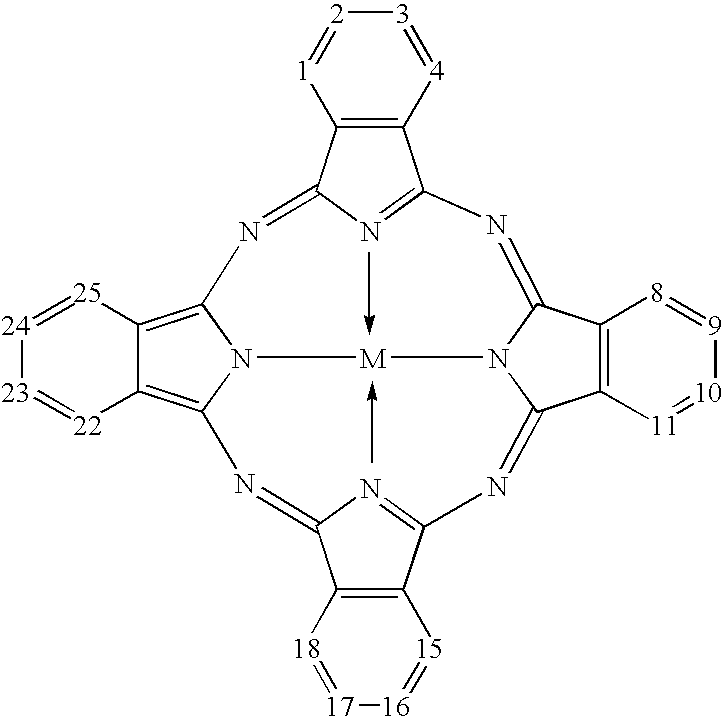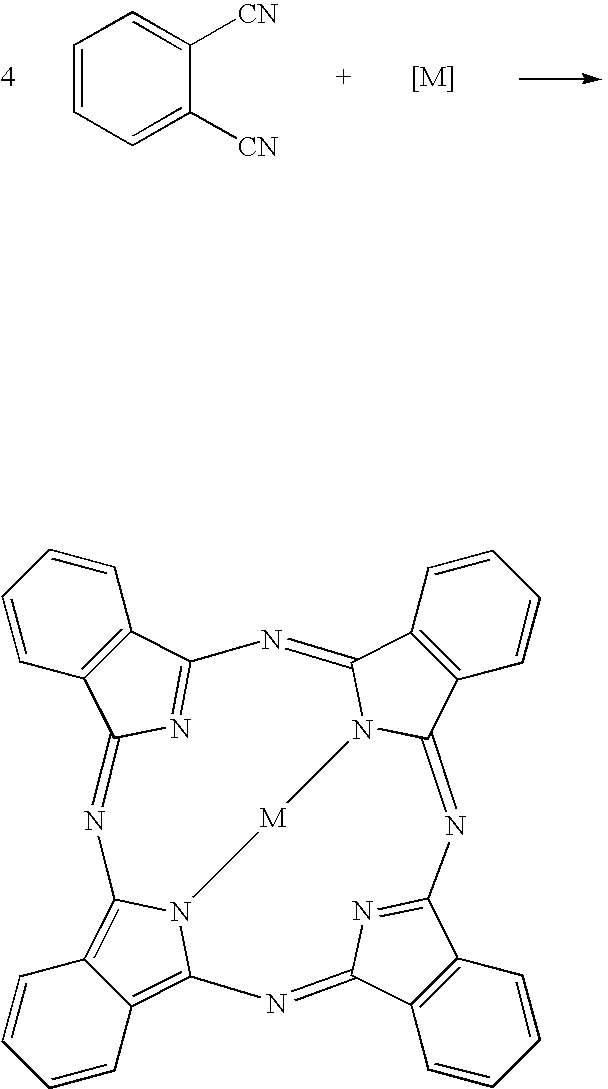Titanyl phthalocyanine with improved milling properties
a technology of phthalocyanine and titanyl phthalocyanine, which is applied in the field of electrophotographic pigments, can solve the problems of large quantity of concentrated sulfuric acid that must be used and the subsequent disposal of such sulfuric acid, and the milling process is typically a slower process, so as to achieve the effect of improving milling properties
- Summary
- Abstract
- Description
- Claims
- Application Information
AI Technical Summary
Benefits of technology
Problems solved by technology
Method used
Image
Examples
example 1
SYNTHETIC EXAMPLE. 90 / 9 PcTiO / 2,3-Cl2PcTiO
[0058]A mixture of phthalonitrile (49.97 g; 0.390 mol), 4,5-dichlorophthalonitrile (1.97 g; 0.0100 mole), benzamide (60.2 g; 0.50 mole), xylenes (90 mL), and 1-pentanol (52 mL; 0.48 mole) was stirred for 30 min to form a homogeneous slurry, then treated with titanium(IV) butoxide (36 mL; 0.102 mol). The reaction mixture was refluxed for 6 hr, cooled to room temperature, and filtered with xylene washing. The damp solid product was slurried four times in 1.6-L of hot N,N-dimethylformamide, once in 1.6-L of 50% aqueous methanol, once in 1.6-L of methanol, collected by filtration and dried under vacuum to yield 44.9 g (77%) of dark blue pigment. Analysis by mass spectrometry showed product ions at m / z 576 (M+, PcTiO) and 644 (22%, Cl2PcTiO). Neutron activation analysis detected 1.4 wt % Cl (calcd=1.22%) and 8.3 wt % Ti (calcd 8.21%).
example 2
COMPARATIVE SYNTHETIC EXAMPLE. PcTiO
[0059]The procedure of the Synthetic Example was followed, with 51.2 g (0.40 mol) of phthalonitrile in place of the mixture of phthalonitrile and 4,5-dichlorophthalonitrile. Mass spectrum: m / z 576 (M+, PcTiO). Neutron activation analysis: 0.02 wt % Cl (calcd 0.00%), 8.5 wt % Ti (calcd 8.31%).
example 3
MILLING EXAMPLE
[0060]The PcTiO / 2,3-Cl2PcTiO mixture from the Synthetic Example (10.0 g) and 1200 g of 3-mm stainless steel shot were combined in a 16-oz. glass jar and roll-milled for 7 days at 75 rpm. Dichloromethane (200 mL) was added and the roll milling was continued for another 24 hours. The pigment was washed from the steel shot with solvent and collected by filtration. The X-ray diffraction spectrum of the pigment matched that of the optimum crystal form for electrophotography, characterized by peaks at 7.4 (maximum intensity peak), 10.2, 12.7, 13.1, 15.1, 16.1, 17.2, 18.3, 22.4, 24.2, 25.4, and 28.8±0.22 degrees-2θ.
PUM
| Property | Measurement | Unit |
|---|---|---|
| temperature | aaaaa | aaaaa |
| structure | aaaaa | aaaaa |
| mole fractions | aaaaa | aaaaa |
Abstract
Description
Claims
Application Information
 Login to View More
Login to View More - R&D
- Intellectual Property
- Life Sciences
- Materials
- Tech Scout
- Unparalleled Data Quality
- Higher Quality Content
- 60% Fewer Hallucinations
Browse by: Latest US Patents, China's latest patents, Technical Efficacy Thesaurus, Application Domain, Technology Topic, Popular Technical Reports.
© 2025 PatSnap. All rights reserved.Legal|Privacy policy|Modern Slavery Act Transparency Statement|Sitemap|About US| Contact US: help@patsnap.com



